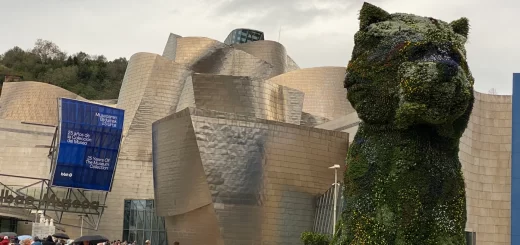As Spain’s cultural capital, Toledo’s heritage of harmony among Christians, Jews and Muslims celebrated

El Greco’s famous view of Toledo captured in the 1500s can be seen today from the patio of a parador across the Tajo River.
Janet Podolak — The News-Herald
Still the cultural and religious center of Spain, Toledo once was the country’s capital. Because the hilly small city dozed off the grid for decades, it’s remarkably well-preserved and retains the imprint of its Christian, Jewish and Muslim heritage.
Sister city to Toledo, Ohio, 4,000 miles away, it celebrates that relationship with a street named Toledo Ohio in its city center within the ancient walls. And, in tribute to Toledo, Spain’s long tradition of sword-making, the Ohio city’s newspaper was named The Blade.

A tribute to the Ohio Toledo is shown with a street name in the old city.
Janet Podolak — The News-Herald
Smack-dab in the center of Spain, Toledo is perched atop a circular hill with the Toledo Cathedral in the middle of the oldest part of town. The famous city view captured in the 1500s by El Greco still can be seen from the patio of a Parador
high on a hill across the Tajo River from the city. Go at sunset and grab a table on the patio to enjoy a glass of wine as the setting sun turns the city golden.
Only 10,000 people live within the old city’s walls, although the population of Toledo’s metropolitan area is eight times that. Its medieval streets, full of sights, sounds and often delectable scents, twist around and seem mostly uphill. Knee strengthening exercises are well advised before you go since it’s a city best seen on foot and the terrain can be challenging.
Begun as a transportation hub by the Romans, Toledo had a thriving Jewish population for hundreds of years. After the fall of Rome, it became a Visigoth capital, and in 700 it was taken over by Muslims called Moors, who ruled Spain for centuries.
From the Middle Ages, Toledo was known for its cultural diversity and for the harmony in which its Christian, Jewish and Muslim populations lived when rulers Ferdinand and Isabella expelled the Jews. A few years ago, in an apology to the Jews, Spain granted automatic citizenship to anyone descended from those Jews who in 1492 were ordered to depart, convert or die.
Many of its churches subsequently were built where mosques and synagogues once stood, adding to the complexity of the city. After Toledo was reconquered by Christians in 1085, many Moors remained in the city and were respected as scholars and for their craftsmanship in making swords.

Handcrafting of a sword, done in much the same way for hundreds of years, can be seen in a shop near Toledo’s famous cathedral.
Janet Podolak — The News-Herald
Although many tourist shops in Toledo sell swords, a visit to the shop operated by Mariano Zamorano gives insight into the laborious sword-making process to which generations of his family have been dedicated. His shop, situated in the former stables of the palace not far from the city’s famous cathedral, is crowded with swords and knives being created over several days by a trio of workers who craft them by hand.
He told us some of the process to make carbon steel is done outside the city because of the noise involved. As Zamorano led our small group into his shop, we noticed one of his fingers was missing. That, he told us, was the result of an accident while making a very sharp sword.
That artisanal process has changed little since it was handed down by the Muslims in the Middle Ages, he said.
The entry of the shop displays swords, daggers and chefs’ knives available for sale
Consider Toledo’s vast cathedral a must when visiting this city. Although difficult to fully appreciate from outside because of the crowded streets surrounding it, the cathedral is one of Europe’s best, boasting a huge collection of art that includes many world-class works by El Greco. The artist, who was born in Greece, was called El Greco because Spaniards had difficulty pronouncing his name: Domenikos Theotokopoulos. He fell in love with Toledo and spent the last three decades of his life living and painting in the city.
Built over 250 years where a mosque once stood, the cathedral is mostly Gothic in style with elaborate wood carvings, wrought-iron work and 500-year-old stained glass windows. Its sacristy is adorned with 19 El Grecos, along with masterpieces by Goya, Carravaggio, Bellini and others.
The Transparente, a hole cut into the ceiling in the 1700s to let sunlight fall on the altar, is unique to the cathedral. The opening faces east, so try to be there in the morning. Carved from marble, it’s a riot of intricate cherubs, angels, and archangels. A pair of faded red hats once belonging to long-dead Catholic cardinals hang from the edges of the hole. Cardinals, we learned, get to choose where in the cathedral they wish to be buried, and their hats hang over that spot until they rot.

An east-facing hole surrounded by cherubs and angels was put into the Toledo Cathedral’s ceiling in the 1700s so the morning sun would light the altar.
Janet Podolak — The News-Herald
The 10-foot-high, 430-pound golden monstrance presides over the cathedral’s treasury, where it is kept when it’s not being paraded through the city for the festival of Corpus Christi holding the Communion wafer. Built in 1517, it’s embedded with diamonds, emeralds and rubies in 400 pounds of gold-plated silver. Inside is 35 pounds of solid gold.

The Toledo Cathedral’s towering monstrance, built to hold the communion wafer, is gold and silver embedded with diamonds, rubies and emeralds.
Janet Podolak — The News-Herald
Outside the cathedral, the sweet honey and almond fragrance of marzipan led us to a one-time 17th-century home that today is the headquarters for Santo Tome, a company that makes marzipan for more than a dozen shops around Toledo. Half of the 40 tons of the candy is made for the Christmas season, while the remaining half is made the rest of the year. Seventh-generation family member Ana de Mesa Garode showed us around.
“Italy and Germany also have marzipan traditions,” she said. “But we make it differently.”

Marzipan, a confection made in Toledo of almonds and honey, is found in shops throughout the city.
Janet Podolak — The News-Herald
The marzipan made in Toledo is composed of 57 percent sweet marcona almonds, ground into a flour, with 40 percent sugar and 3 percent honey. The family’s confection is baked, while in Germany it is prepared in a bain marie and in Italy it’s dried. A 10-foot-tall Don Quixote made entirely of marzipan presides over the bakery counters in the showroom, where a steady stream of folks comes to buy it.
As we continued our exploration of Toledo, we saw marzipan being sold on almost every street corner.
A few miles outside of town, we met Alfonso Valero at his farm, where Spain’s Manchego cheese is made. Three generations of his family have made the raw sheep and goat’s milk cheeses under the brand names of Artequeso and Buenalba.

Alfonso Valero shows off the Manchego cheese made in many flavors at his farm outside Toledo. It’s sold online in America.
Janet Podolak — The News-Herald
The family raises its own La Mancha sheep and varies the process of curdling and cutting using milk-specific lactic bacteria. Once we saw the process, which takes several months for curing the cheeses, we followed Valero on foot to his nearby home. There, he offered up an outdoor buffet of cheeses with flavors of rosemary, red wine, and smoked paprika. The cheeses, which are delicious, can be found online and in some U.S. cities.




Recent Comments